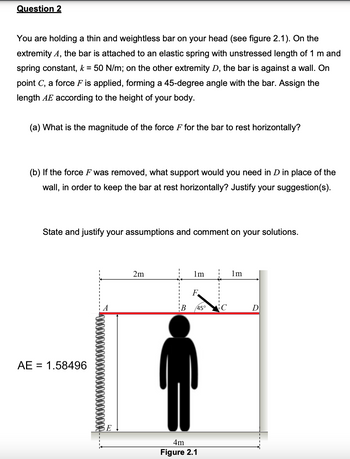
Elements Of Electromagnetics
7th Edition
ISBN: 9780190698614
Author: Sadiku, Matthew N. O.
Publisher: Oxford University Press
expand_more
expand_more
format_list_bulleted
Concept explainers
Question
help with all parts of the question thanks

Transcribed Image Text:Question 2
You are holding a thin and weightless bar on your head (see figure 2.1). On the
extremity A, the bar is attached to an elastic spring with unstressed length of 1 m and
spring constant, k = 50 N/m; on the other extremity D, the bar is against a wall. On
point C, a force F is applied, forming a 45-degree angle with the bar. Assign the
length AE according to the height of your body.
(a) What is the magnitude of the force F for the bar to rest horizontally?
(b) If the force F was removed, what support would you need in D in place of the
wall, in order to keep the bar at rest horizontally? Justify your suggestion(s).
State and justify your assumptions and comment on your solutions.
2m
1m
1m
AE = 1.58496
SE
F
B 45°
4m
Figure 2.1
C
D
Expert Solution
This question has been solved!
Explore an expertly crafted, step-by-step solution for a thorough understanding of key concepts.
This is a popular solution
Trending nowThis is a popular solution!
Step by stepSolved in 2 steps

Knowledge Booster
Learn more about
Need a deep-dive on the concept behind this application? Look no further. Learn more about this topic, mechanical-engineering and related others by exploring similar questions and additional content below.Similar questions
- A suspended date that's able to pivot from the top seperates two liquids. There is a stopper that prevents the gate opening anti-clockwise. The gate has a height of 0.5m. The liquid on the right is twice as dense as the liquid on the left. The liquid on the left has a depth of 0.3m. 1) What is the minimum depth of liquid on the right for the gate to open. 2) Comment on the ability to solve this question if the liquid on the left was 1m (filled to the top)arrow_forwardPls help! ENGINEERING MECHANICS. RATE WILL BE GIVEN! Mulitipe Choice Which of the following statements is correct?a. All statements are correctb. A particle moving in a curved path with a constant speed has a zero acceleration. c. A particle moving in a curved path with a constant speed has a non-zero acceleration. d. A particle moving in a straight path with varying speed has a zero acceleration. e. A particle moving in a straight path with a constant speed has a non-zero acceleration.arrow_forwardCan you please do 5.67. Thxarrow_forward
- What does Pascal's law state? Multiple Choice The pressure applied to a confined fluid increases the pressure throughout by the same amount. The pressure applied to a confined fluid increases the pressure on the parallel surfaces. The pressure applied to a confined fluid is proportional to the volume of the fluid. The pressure applied to a confined fluid increases the pressure on the perpendicular surface.arrow_forwardLESSON: AUTODESK AUTOCAD Choose from the choices:arrow_forward
arrow_back_ios
arrow_forward_ios
Recommended textbooks for you
 Elements Of ElectromagneticsMechanical EngineeringISBN:9780190698614Author:Sadiku, Matthew N. O.Publisher:Oxford University Press
Elements Of ElectromagneticsMechanical EngineeringISBN:9780190698614Author:Sadiku, Matthew N. O.Publisher:Oxford University Press Mechanics of Materials (10th Edition)Mechanical EngineeringISBN:9780134319650Author:Russell C. HibbelerPublisher:PEARSON
Mechanics of Materials (10th Edition)Mechanical EngineeringISBN:9780134319650Author:Russell C. HibbelerPublisher:PEARSON Thermodynamics: An Engineering ApproachMechanical EngineeringISBN:9781259822674Author:Yunus A. Cengel Dr., Michael A. BolesPublisher:McGraw-Hill Education
Thermodynamics: An Engineering ApproachMechanical EngineeringISBN:9781259822674Author:Yunus A. Cengel Dr., Michael A. BolesPublisher:McGraw-Hill Education Control Systems EngineeringMechanical EngineeringISBN:9781118170519Author:Norman S. NisePublisher:WILEY
Control Systems EngineeringMechanical EngineeringISBN:9781118170519Author:Norman S. NisePublisher:WILEY Mechanics of Materials (MindTap Course List)Mechanical EngineeringISBN:9781337093347Author:Barry J. Goodno, James M. GerePublisher:Cengage Learning
Mechanics of Materials (MindTap Course List)Mechanical EngineeringISBN:9781337093347Author:Barry J. Goodno, James M. GerePublisher:Cengage Learning Engineering Mechanics: StaticsMechanical EngineeringISBN:9781118807330Author:James L. Meriam, L. G. Kraige, J. N. BoltonPublisher:WILEY
Engineering Mechanics: StaticsMechanical EngineeringISBN:9781118807330Author:James L. Meriam, L. G. Kraige, J. N. BoltonPublisher:WILEY

Elements Of Electromagnetics
Mechanical Engineering
ISBN:9780190698614
Author:Sadiku, Matthew N. O.
Publisher:Oxford University Press

Mechanics of Materials (10th Edition)
Mechanical Engineering
ISBN:9780134319650
Author:Russell C. Hibbeler
Publisher:PEARSON

Thermodynamics: An Engineering Approach
Mechanical Engineering
ISBN:9781259822674
Author:Yunus A. Cengel Dr., Michael A. Boles
Publisher:McGraw-Hill Education

Control Systems Engineering
Mechanical Engineering
ISBN:9781118170519
Author:Norman S. Nise
Publisher:WILEY

Mechanics of Materials (MindTap Course List)
Mechanical Engineering
ISBN:9781337093347
Author:Barry J. Goodno, James M. Gere
Publisher:Cengage Learning

Engineering Mechanics: Statics
Mechanical Engineering
ISBN:9781118807330
Author:James L. Meriam, L. G. Kraige, J. N. Bolton
Publisher:WILEY